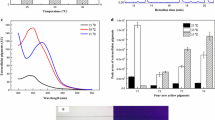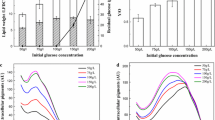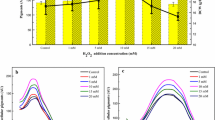Abstract
Monascus pigments are secondary metabolites of Monascus species and are mainly composed of yellow pigments, orange pigments and red pigments. In this study, a larger proportion of Monascus yellow pigments could be obtained through the selection of the carbon source. Hydrophilic yellow pigments can be largely produced extracellularly by Monascus ruber CGMCC 10910 under conditions of high glucose fermentation with low oxidoreduction potential (ORP). However, keeping high glucose levels later in the culture causes translation or a reduction of yellow pigment. We presume that the mechanism behind this phenomenon may be attributed to the redox level of the culture broth and the high glucose stress reaction of M. ruber CGMCC 10910 during high glucose fermentation. These yellow pigments were produced via high glucose bio-fermentation without citrinin. Therefore, these pigments can act as natural pigments for applications as food additives.




Similar content being viewed by others
References
Akihisa TH, Tokuda K, Yasukawa M, Ukiya A, Kiyota N, Sakamoto T, Suzuki N, Tanabe NH (2005) Azaphilones, furanoisophthalides, and amino acids from the extracts of Monascus pilosus-fermented rice (red-mold rice) and their chemopreventive effects. J Agr Food Chem 53(3):562–565
Babitha S, Soccol CR, Pandey A (2007) Effect of stress on growth, pigment production and morphology of Monascus sp. in solid cultures. J Basic Microbiol 47(2):118–126
Berovic M (1999) Scale-up of citric acid fermentation by redox potential control. Biotechnol Bioeng 64(5):552–557
Blanc PJ, Laussac JP, Le Bars J, Le Bars P, Loret MO, Pareilleux A, Prome D, Prome JC, Santerre AL, Goma G (1995) Characterization of monascidin A from Monascus as citrinin. Int J Food Microbiology 27(1995):201–213
Bruckner R, Titgemeyer F (2002) Carbon catabolite repression in bacteria: choice of the carbon source and autoregulatory limitation of sugar utilization. FEMS Microbiol Lett 209(2):141–148
Carels M, Shepherd D (1977) The effect of different nitrogen sources on pigment production and sporulation of Monascus species in submerged shaken culture. Can J Microbiol 23(10):1360–1372
Chen M, Johns MR (1994) Effect of carbon source on ethanol and pigment production by Monascus purpureus. Enzym Microb Technol 16:584–590
Chen G, Wu Z (2016) Production and biological activities of yellow pigments from Monascus fungi. World J Microb Biot 32(8):136
Chen G, Shi K, Song D, Quan L, Wu Z (2015) The pigment characteristics and productivity shifting in high cell density culture of Monascus anka mycelia. BMC Biotechnol 15(1):1–9
Cheng M, Wu M, Chen I, Tseng M, Yuan G (2011) Chemical constituents from the fungus Monascus purpureus and their antifungal activity. Phytochem Lett 4(3):372–376
Droillard M, Boudsocq M, Barbier-Brygoo H, Christiane (2002) Different protein kinase families are activated by osmotic stresses in Arabidopsis thaliana cell suspensions. FEBS Lett 527:43–50
Du C, Zhang Y, Li Y, Cao Z (2007) Novel redox potential-based screening strategy for rapid isolation of Klebsiella pneumoniae mutants with enhanced 1,3-propanediol-producing capability. Appl Environ Microb 73(14):4515–4521
Dufossé L, Galaup P, Yaron A, Arad SM, Blanc PKN, Murthy C, Ravishankar GA (2005) Microorganisms and microalgae as sources of pigments for food use: a scientific oddity or an industrial reality? Trends Food Sci Tech 16(9):389–406
Edward J, Paul R, Elaine F (1991) Reduced Monascus pigment derivatives as yellow food colorats. United States Patent. Patent Number: 5,013,564 Date of Patent: May 7, 1991
Feng Y, Shao Y, Chen F (2012) Monascus pigments. Appl Microbiol Biot 96(6):1421–1440
Hajjaj H, Klaebe A, Loret MO, Tzedakis GGAPT (1997) Production and identification of N-glucosylrubropunctamine and N-glucosylmonascorubramine from Monascus ruber and occurrence of electron donor-acceptor complexes in these red pigments. Appl Environ Microbiol 63(7):2671–2678
Hsu Y, Hsu L, Liang Y, Kuo Y, Pan T (2010) Monaphilones A−C, three new antiproliferative azaphilone derivatives from Monascus purpureus NTU 568. J Agr Food Chem 58(14):8211–8216
Hu Z, Zhang X, Wu Z, Qi H, Wang Z (2012) Export of intracellular Monascus pigments by two-stage microbial fermentation in nonionic surfactant micelle aqueous solution. J Biotechnol 162(2–3):202–209
Inouye Y, Nakanishi K, Nishikawa H, Ohashi M, Terahara A, Yamamura S (1962) Structure of monascoflavin. Tetrahedron 18:1195–1203
Jongrungruangchok S, Kittakoop P, Yongsmith B, Bavovada R, Tanasupawat S, Lartpornmatulee N, Thebtaranonth Y (2004) Azaphilone pigments from a yellow mutant of the fungus Monascus kaoliang. Phytochemistry 65(18):2569–2575
Jung H, Choe D, Nam K, Cho K, Shin CS (2011) Degradation patterns and stability predictions of the original reds and amino acid derivatives of Monascus pigments. Eur Food Res Technol 232(4):621–629
Juzlova P, Martinkova L, Kren V (1996) Secondary metabolites of the fungus Monascus: a review. J Ind Microbio 16:163–170
Kang B, Zhang X, Wu Z, Wang Z, Park S (2014) Production of citrinin-free Monascus pigments by submerged culture at low pH. Enzyme Microb Tech 55:50–57
Kazuo S, Yukinari Y, Toshiyuki H, Ohba T (2000) On-line measurement of intracellular ATP of Saccharomyces cerevisiae and pyruvate during sake mashing. J Biosci Bioeng 90(3):230–294
Kiaergaard L, Joergensen BB (1976) Maintenance of a constant redox potential during fermentation by automatical addition of glucose. In: Dellweg, H. (ed.): Abstracts of papers, p. 24. Fifth International Fermentation Symposium. Verlag Versuchs- und Lehranstalt für Spiritusfabrikation und Fermentationstechnologie in Institut für Gärungsgewerbe und Biotechnologie zu Berlin (West)
Klinsupa W, Phansiri S, Thongpradis P, Yongsmith B, Pothiratana C (2016) Enhancement of yellow pigment production by intraspecific protoplast fusion of Monascus spp. yellow mutant (ade−) and white mutant (prototroph). J Biotechnol 217:62–71
Kubicek CP, Rohr M (1985) Citric acid fermentation. Crit Rev Biotechnol 3(4):331–373
Lee C, Wen J, Hsu Y, Pan T (2013) Monascus-fermented yellow pigments monascin and ankaflavin showed antiobesity effect via the suppression of differentiation and lipogenesis in obese rats fed a high-fat diet. J Agr Food Chem 61(7):1493–1500
Lone B (2001) Determinants of consumer attitudes and purchase intentions with regard to genetically modified foods—results of a cross-national survey. J Consumer Policy 24:23–61
Monks DE, Aghoram K, Courtney PD (2001) Hyperosmotic stress induces the rapid phosphorylation of a soybean phosphatidylinositol transfer protein homolog through activation of the protein kinases SPK1 and SPK2. Plant Cell 13(5):1205–1219
Ouvry A, Wache Y, Tourdot-Marechal R, Divies C, Cachon R (2002) Effects of oxidoreduction potential combined with acetic acid, NaCl and temperature on the growth, acidification, and membrane properties of Lactobacillus plantarum. FEMS Microbiol Lett 214:257–261
Patakova P (2013) Monascus secondary metabolites: production and biological activity. J Ind Microbiol Biot 40(2):169–181
Rasheva T, Kujumdzieva A, Hallet JN (1997) Lipid production by Monascus purpureus albino strain. J Biotechnol 56(3):217–224
San K, Bennett GN, Berríos-Rivera SJ, Vadali RV, Yang Y, Horton E, Rudolph FB, Sariyar B, Blackwood K (2002) Metabolic engineering through cofactor manipulation and its effects on metabolic flux redistribution in Escherichia coli. Metab Eng 4(2):182–192
Shi Y, Liao VH, Pan T (2012) Monascin from red mold dioscorea as a novel antidiabetic and antioxidative stress agent in rats and Caenorhabditis elegans. Free Radical Bio Med 52(1):109–117
Shi K, Song D, Chen G, Pistolozzi M, Wu Z, Quan L (2015) Controlling composition and color characteristics of Monascus pigments by pH and nitrogen sources in submerged fermentation. J Biosci Bioeng 120(2):145–154
Su N, Lin Y, Lee M, Ho C (2005) Ankaflavin from Monascus-fermented red rice exhibits selective cytotoxic effect and induces cell death on hep g2 cells. J Agr Food Chem 53(6):1949–1954
Wang G, Wang Y, Ma J, Chen (2009) Effects of different reduced carbon sources on succinic acid production by anaerobic fermentation of recombinant Escherichia coli. China Brewing 204(3):16–19.
Wang Y, Zhang B, Lu L, Huang Y, Xu G (2013) Enhanced production of pigments by addition of surfactants in submerged fermentation of Monascus purpureus H1102. J Agr Food Chem 93(13):3339–3344
Wang B, Zhang X, Wu Z, Wang Z (2015) Investigation of relationship between lipid and Monascus pigment accumulation by extractive fermentation. J Biotechnol 212:167–173
Wu Z, Wang M, Chen G (2015) An approach to achieving extracellular water-soluble Monascus yellow pigment by high carbon resource fermentation and its application: China Patent CN2015 10450416.8, 2015–11-04 http://www.cnki.net/
Xiong X, Zhang X, Wu Z, Wang Z (2015) Accumulation of yellow Monascus pigments by extractive fermentation in nonionic surfactant micelle aqueous solution. Appl Microbiol Biot 99(3):1173–1180
Yang Y, Liu B, Du X, Li P, Liang B, Cheng X, Du L, Huang D, Wang L, Wang S (2015) Complete genome sequence and transcriptomics analyses reveal pigment biosynthesis and regulatory mechanisms in an industrial strain, Monascus purpureus YY-1. Sci Rep-UK 5:8331–8339
Zhong S, Zhang X, Wang Z (2015) Preparation and characterization of yellow Monascus pigments. Sep Purie Technol 150:139–144
Author information
Authors and Affiliations
Corresponding author
Ethics declarations
This article does not contain any studies with human participants or animals performed by any of the authors.
Conflict of interest
The authors declare that they have no competing interests.
Funding
This study were funded by the financial support of the National Natural Science Foundation of China (No.: 31271925), the Special Project on the Integration of Industry, Education and Research of Guangdong Province, China (No.: 2013B090600015) and the Science and Technology Program of Guangzhou, China (No.: 2014J4100192).
Rights and permissions
About this article
Cite this article
Wang, M., Huang, T., Chen, G. et al. Production of water-soluble yellow pigments via high glucose stress fermentation of Monascus ruber CGMCC 10910. Appl Microbiol Biotechnol 101, 3121–3130 (2017). https://doi.org/10.1007/s00253-017-8106-y
Received:
Revised:
Accepted:
Published:
Issue Date:
DOI: https://doi.org/10.1007/s00253-017-8106-y




